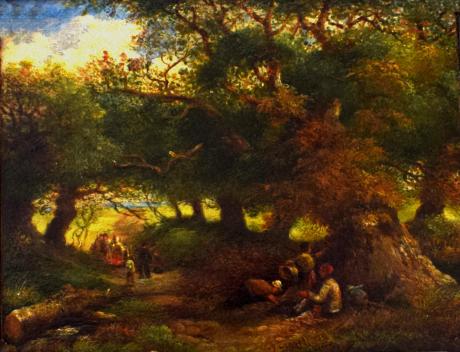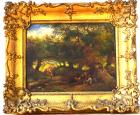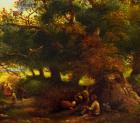"John Linnell " lower right
Linnell, John (1792–1882), landscape and portrait painter, was born on 16 June 1792 in Plum Tree Street, Bloomsbury, London, the fourth and youngest child of James Linnell (1759–1836), woodcarver, framemaker, and picture dealer, and his wife, Mary Susannah, née Welshman (d. 1825). Linnell had a long and very successful career as an artist, but modern assessments of his importance centre on his early work, and on his relationships with his fellow artists William Blake and Samuel Palmer, who became his son-in-law in 1837.
Early years, 1792–1811
Linnell claimed that he had no formal education, but learned to paint by copying works by George Morland for his father. He was introduced to artists by the latter, and c.1804 made visits to Benjamin West, who looked at his sketches and offered advice. In his diary entries for 9 and 14 November 1806 Farington mentioned that his small-scale oil studies had attracted the attention of David Wilkie, Benjamin Haydon, and Sir George Beaumont. In 1805 Linnell entered the Royal Academy Schools, and at about this time he became a pupil of John Varley. With William Mulready and William Henry Hunt, also pupils of Varley, he made oil sketches from nature along the banks of the Thames, for example, Study of Buildings: Sketch from Nature (1806; Tate collection). He was especially close to Mulready, with whom he was to share lodgings between 1809 and 1811. In the evenings, at this early period, c.1805–6, Linnell copied drawings in the house of the art patron Dr Thomas Monro. From 1807 to 1811 he exhibited oil paintings at the Royal Academy and at the British Institution, mainly genre scenes and landscapes which show the influence of seventeenth-century Dutch art, for example, The Quoit Players, 1810, which was bought by Sir Thomas Baring for 75 guineas. At the British Institution Linnell won a premium of 50 guineas in 1809 for Removing Timber in Autumn.
During this period Linnell was apprenticed to his father, having signed an indenture for seven years in 1806.
Early landscapes, 1811–1818
In 1811 Linnell left the Academy Schools. His friendship with Cornelius Varley, brother of John, seems to have stimulated both a religious conversion and a new approach to landscape painting in this year. He joined the Baptist church in January 1812, becoming a member of the chapel at Keppel Street, Bloomsbury, and bought drawing instruments which would enable him to transcribe what he saw with scientific accuracy. He read the writings of William Paley, whose natural theology encouraged Linnell, like many other artists of his time, to regard the study of landscape as a valuable response to the work of God. In his subject matter a new interest in working figures is evident, especially in Kensington Gravel Pits (1812; Tate collection). Many of his watercolour studies in this decade adopt unconventional compositions, suggesting a self-consciously haphazard, informal method of constructing landscape, such as Brick Kiln, Kensington, 1811–12 (priv. coll.). When the Society of Painters in Water Colours changed its name to the Society of Painters in Oil and Water Colours in 1813, Linnell was a founding member, and contributed fifty-two works (probably all oils) to its exhibitions between 1813 and 1820. Many of these were based on sketching trips made in 1813, 1814, and 1815. In 1813, with George Robert Lewis, he visited north Wales, where he was impressed by the wild scenery, writing many years later, ‘I could almost fancy myself living in the times of Jacob and Esau and might expect to meet their flocks’ (Linnell, autobiography, 45–6). In 1814 he was in Derbyshire, making drawings for an edition of I. Walton and C. Cotton's Compleat Angler, commissioned by the Baptist publisher Samuel Bagster; in 1815 he went to Southampton and the Isle of Wight. The watercolour sketches of this period are remarkably fresh and have been the basis for the reassessment of Linnell's work from the 1970s onwards. Linnell himself, however, seems not to have exhibited them, regarding them as raw material for landscapes in oil. Exhibited landscapes of this time, such as The River Kennet Near Newbury (1815; FM Cam.), follow the sketches closely, implying a commitment to naturalism on Linnell's part. In 1818 he exhibited his first religious painting, St John Preaching in the Wilderness.
This period of Linnell's life came to an end with his marriage to Mary Ann Palmer (1796–1865, no relation to the artist Samuel Palmer) in 1817. The couple travelled to Scotland for a civil ceremony, Linnell believing that the Church of England one was blasphemous. He had taught himself Greek and Hebrew so that he could read the Bible in the original, since he held that the Authorized Version was corrupt. Just as he went to the fountainhead of nature in his landscape studies, so he felt that he should go to the works of God rather than man in his religious studies.
Friend and patron of Blake and Palmer, 1818–1829
In 1818 Linnell was introduced, by George Cumberland junior, to William Blake. Their shared attitudes to art and religion brought about a strong rapport, and Linnell played an important role in Blake's last years. He commissioned the engravings for the Book of Job (1825) in 1823 and the watercolour illustrations to Dante's Divine Comedy (1827) in 1824. He gave Blake, who was often unable to work through illness, a regular income, and arranged his funeral when he died in 1827. Both men were part of a circle of collectors, artists, and writers, which included Mr and Mrs Charles Aders and Henry Crabb Robinson, who were interested in early Renaissance art. Linnell himself bought early paintings in this period of his life, including one attributed to Lucas van Leyden in 1822. Linnell also introduced Blake to Dr Thornton, the Linnell family doctor, in 1819; it was Thornton who commissioned the woodcut illustrations for his translation of Virgil's Eclogues, which were to be so much admired by Samuel Palmer.
Linnell met Palmer in 1822 and introduced him to Blake in 1824. In his notebooks Palmer recorded the advice of both men, which led him away from the conventional watercolour style of his day into a more intense and visionary engagement with landscape. It was Palmer's opinion at this time that ‘it pleased God to send Mr Linnell as a good angel from Heaven to pluck me from the pit of modern art’ (Palmer, Life and Letters, 14). After Blake's death, Linnell made visits to Palmer at Shoreham (August and September 1828 and June 1829) and encouraged him to make studies from nature. Surviving correspondence reveals a stimulating relationship, not without its tensions as Palmer feared naturalism was a diversion from his real mission, which was to paint his inner visions in keeping with the ideas of Blake. However, Linnell commissioned studies from Palmer, thus helping to support him when the younger artist was selling very few pictures. Religious beliefs were to be a growing source of disagreement: Palmer was drawn to high Anglicanism, while Linnell became increasingly low church, breaking with the Baptists in the 1820s, considering membership of the Society of Friends in 1830, and eventually joining the Plymouth Brethren in 1843. In 1848 he left the Plymouth Brethren when his son John was accused by them of heresy, and henceforth belonged to no established religious group. His faith remained strong, however, grounded in his conviction of the necessity of going directly to the source of divine revelation. In later life he published pamphlets expounding his views on the corrupt nature of existing translations of the Bible: Diatheekee, Covenant not Testament (1856) and Burnt offering not in the Hebrew Bible: shown by a revised version of the first part of Leviticus (1864).
Society portrait painter, 1821–1846
Following his marriage in 1817, Linnell's first child, Hannah (who married Samuel Palmer), was born in 1818; by 1835 he had nine children. The need to earn a steady income led him to concentrate on portrait commissions. In 1820, when the Society of Painters in Oil and Water Colours resumed its original title and reverted to showing watercolours only, Linnell resigned and began exhibiting once again at the Royal Academy, where he had pictures almost every year from 1821 to 1881. Between 1824 and 1846 nearly all his exhibits were portraits. His first portrait had been of John Martin, pastor of the Keppel Street Chapel, in 1812: Linnell made and published an engraving, copies of which found a ready market among members of the Baptist church. In the 1820s, however, he acquired royal and aristocratic patronage and painted miniatures, including one of Princess Sophia Matilda (1821; Royal Collection), the daughter of William Henry, duke of Gloucester. Other sitters included the earl of Denbigh (1823), Lady Lyndhurst (1830), the Revd Thomas Malthus (1833), the marquess of Bristol (1835), the marquess of Lansdowne (1840), and Thomas Carlyle (1844). His portraits of William Mulready (1833) and Sir Robert Peel (1838) are in the National Portrait Gallery, London, which also holds a Self-Portrait (c.1860). Linnell's portraits show the influence of Renaissance prototypes, as well as that of contemporaries such as Sir Thomas Lawrence: a notable example is the group portrait of Lady Torrens and her Family (1820; Elvehjem Museum of Art, University of Wisconsin, Madison, USA). In addition to commissioned portraits, Linnell made many informal studies of his friends, family, and fellow artists, including Blake and Palmer. There are also portraits of obscure sitters, made in part payment to the craftsmen who worked on the house he had built at 38 Porchester Terrace, Bayswater, in the late 1820s and early 1830s.
In addition to his work in portraiture and landscape, Linnell was an accomplished copyist and printmaker. Between 1828 and 1834 he executed watercolour drawings of pictures in the National Gallery which were engraved by John Pye and published in The British Gallery. He made several finished copies in oil of works by the old masters, including Titian, Rembrandt, and Raphael, some for his own use, others on commission. In 1834 he published Michelangelo's Frescoes in the Sistine Chapel, a series of mezzotints made from drawings in Samuel Rogers's collection which Linnell considered to be Michelangelo's working drawings for the chapel. He also made etchings, engravings, and mezzotints after his own portraits, and mezzotints after paintings by his friends William Collins and John Varley. Linnell acquired a large collection of old master prints, including works by Dürer, Holbein, Marcantonio Raimondi, Bonasone, Rembrandt, and Claude.
In 1821 Linnell put his name down for an associateship of the Royal Academy, and continued trying to get elected until 1842, when he withdrew his name. He suspected that malicious gossip, for which he held John Constable partly to blame, had prevented his election: Linnell and his family had stayed with Constable's friend D. C. Read at Southampton in 1819, Read had accused Linnell of meanness, and Linnell believed that Constable had talked about the matter to academicians. Much later on, in 1867 Linnell was asked if he would agree to his name being put down for an associateship, but refused. By this time Linnell's continued exclusion from membership of the academy was perceived as scandalous: Millais and Eastlake had cited him as an artist who should have been elected, at a government inquiry into the Royal Academy in 1863. Following a further dispute with the academy over their failure to hang a painting in 1867, Linnell wrote a pamphlet, The Royal Academy, a National Institution (1869), which was highly critical of the exclusiveness of the main body of academicians.
Linnell claimed that he painted portraits to live, but he lived to paint poetical landscapes (Linnell, autobiography, 16); thus, as soon as his finances permitted he moved out into the country and concentrated on landscape painting.
Pastoral landscapes, 1847–1882
From 1847 onwards almost all Linnell's exhibits at the Royal Academy were landscapes. Like other successful Victorian artists, he was able to buy land and have a substantial house built: the site he chose was at Redstone Wood, Redhill, in Surrey. Here he painted landscapes which were sold to north of England merchants and industrialists, often through the London dealers Agnews who also had a saleroom in Manchester. His professed ambition was to paint biblical scenes, such as The Eve of the Deluge (1848; Cleveland Museum of Art), which was bought by Joseph Gillott, Birmingham pen manufacturer, for £1000. But most of his patrons preferred pastoral landscapes, especially the harvest scenes, peopled by cheerful, ruddy-cheeked, smock-frocked labourers, which he made his speciality, such as Harvest Home, Sunset, the Last Load (1854; Tate collection). Linnell owned arable fields around his house, which he let out to farmers, and he appreciated the paradox that by painting a scene in one of these fields he could make more money than the farmer would get for his crop (Story, 2.33). As well as being accessible, the subject of harvest was full of symbolic meaning for Linnell, as a demonstration of divine benevolence.
While Linnell continued to sketch from nature, and to use sketches as the basis for his exhibited pictures, such as The Noonday Rest (1865; Tate collection), his later landscapes are more conventional and idealized than his earlier work. Their Claudian compositions and sketchy handling were somewhat out of step with the tastes of the 1850s, influenced by the Pre-Raphaelites, and dealers repeatedly urged him to give more finish to his paintings. However, his works sold so readily that he had little incentive to change his style: his landscape sketchbook (BM) records that his last landscape was sold ‘off the easel’ (that is, before being sent to exhibition) for £1000 in 1879, when he was eighty-seven.
At Redstone Wood, Linnell lived like a patriarch, surrounded by his large family, all of whom painted, James (1823–1905) and William (1826–1906) being important artists in their own right. Linnell baked his own bread and brewed his own beer, and educated the children himself, teaching them to read and write, draw and paint, grind corn and bake bread. In 1865 his first wife died and in 1866 he married Mary Ann (Marion) Budden (d. 1886), who survived him.
Linnell's reputation
In his lifetime Linnell was a successful and much admired artist. However, his strongly held views and his legalistic approach to business and family transactions caused difficulties with some of his relatives and acquaintances. He operated strict business terms, requesting deposits in advance and payment in full on delivery, and insisted on decisions being recorded in writing and signed by all the relevant parties. His relationship with Samuel Palmer, who married his daughter Hannah in 1837, cooled during their Italian honeymoon, and remained problematic. Initially there were tensions because the Palmers stayed away longer than they had planned, and because of the pressures induced by Linnell's commission for them to colour his set of mezzotints of the Sistine Chapel frescoes. Later on, their religious disagreements surfaced, and Palmer came to resent Linnell's interference in the lives of the couple, which was exacerbated by Palmer's failure to earn much through his art. In their lifetimes it was Palmer who struggled while Linnell enjoyed success; in their posthumous reputations, positions have been reversed, and Palmer is now seen as the more original and important of the two artists.
Like that of many successful Victorian artists, Linnell's reputation has suffered because of new developments in the art of the late nineteenth and early twentieth centuries, and because of his tendency to repeat a selling formula in his landscapes, the style of which remained very similar from the 1840s to the 1880s. Reassessment of his work since the 1970s has centred on his early landscapes, and especially on the studies from nature shown at the exhibition at Colnaghis in 1973.
In the literature on Palmer, Linnell often appears as a villain rather than ‘a good angel’. Palmer's son, A. H. Palmer, compiled his father's Life and Letters in 1892, and also copied out Linnell's journals, with the intention of writing a biography of Linnell. However, his judgement of Linnell, whom he blamed for his own father's lack of worldly success, became increasingly bitter and has affected subsequent writers on Palmer. In recent years writers on both artists have tried to correct this imbalance and reach a fairer assessment of Linnell's character and achievement.
John Linnell died at Redstone Wood on 20 January 1882 and was buried at Redhill, Surrey.
Christiana Payne DNB



